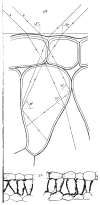Spectrum of Light as a Determinant of Plant Functioning: A Historical Perspective
- PMID: 32192016
- PMCID: PMC7151614
- DOI: 10.3390/life10030025
Spectrum of Light as a Determinant of Plant Functioning: A Historical Perspective
Abstract
The significance of the spectral composition of light for growth and other physiological functions of plants moved to the focus of "plant science" soon after the discovery of photosynthesis, if not earlier. The research in this field recently intensified due to the explosive development of computer-controlled systems for artificial illumination and documenting photosynthetic activity. The progress is also substantiated by recent insights into the molecular mechanisms of photo-regulation of assorted physiological functions in plants mediated by photoreceptors and other pigment systems. The spectral balance of solar radiation can vary significantly, affecting the functioning and development of plants. Its effects are evident on the macroscale (e.g., in individual plants growing under the forest canopy) as well as on the meso- or microscale (e.g., mutual shading of leaf cell layers and chloroplasts). The diversity of the observable effects of light spectrum variation arises through (i) the triggering of different photoreceptors, (ii) the non-uniform efficiency of spectral components in driving photosynthesis, and (iii) a variable depth of penetration of spectral components into the leaf. We depict the effects of these factors using the spectral dependence of chloroplast photorelocation movements interlinked with the changes in light penetration into (light capture by) the leaf and the photosynthetic capacity. In this review, we unfold the history of the research on the photocontrol effects and put it in the broader context of photosynthesis efficiency and photoprotection under stress caused by a high intensity of light.
Keywords: action spectrum of photosynthesis; chloroplast photorelocation; inter-leaf light intensity gradient; regulatory and energy-supplying functions of light.
Conflict of interest statement
The authors declare no conflict of interest.
Figures




Similar articles
-
Non-invasive, whole-plant imaging of chloroplast movement and chlorophyll fluorescence reveals photosynthetic phenotypes independent of chloroplast photorelocation defects in chloroplast division mutants.Plant J. 2015 Oct;84(2):428-42. doi: 10.1111/tpj.13009. Plant J. 2015. PMID: 26332826
-
Recent advances in understanding the molecular mechanism of chloroplast photorelocation movement.Biochim Biophys Acta. 2014 Apr;1837(4):522-30. doi: 10.1016/j.bbabio.2013.12.004. Epub 2013 Dec 12. Biochim Biophys Acta. 2014. PMID: 24333784 Review.
-
Molecular basis of chloroplast photorelocation movement.J Plant Res. 2016 Mar;129(2):159-66. doi: 10.1007/s10265-016-0788-1. Epub 2016 Jan 21. J Plant Res. 2016. PMID: 26794773 Review.
-
Response of soybean photosynthesis and chloroplast membrane function to canopy development and mutual shading.Plant Physiol. 1991 Sep;97(1):245-52. doi: 10.1104/pp.97.1.245. Plant Physiol. 1991. PMID: 16668377 Free PMC article.
-
Acclimation of plants to light gradients in leaf canopies: evidence for a possible role for cytokinins transported in the transpiration stream.J Exp Bot. 2001 Jul;52(360):1563-74. doi: 10.1093/jexbot/52.360.1563. J Exp Bot. 2001. PMID: 11457917
Cited by
-
Spectral composition of LED light differentially affects biomass, photosynthesis, nutrient profile, and foliar nitrate accumulation of lettuce grown under various replacement methods of nutrient solution.Food Sci Nutr. 2023 Oct 10;11(12):8143-8162. doi: 10.1002/fsn3.3735. eCollection 2023 Dec. Food Sci Nutr. 2023. PMID: 38107131 Free PMC article.
-
An Overview of Potential Natural Photosensitizers in Cancer Photodynamic Therapy.Biomedicines. 2023 Jan 16;11(1):224. doi: 10.3390/biomedicines11010224. Biomedicines. 2023. PMID: 36672732 Free PMC article. Review.
-
Ratio of Intensities of Blue and Red Light at Cultivation Influences Photosynthetic Light Reactions, Respiration, Growth, and Reflectance Indices in Lettuce.Biology (Basel). 2022 Jan 1;11(1):60. doi: 10.3390/biology11010060. Biology (Basel). 2022. PMID: 35053058 Free PMC article.
-
Tailoring confocal microscopy for real-time analysis of photosynthesis at single-cell resolution.Cell Rep Methods. 2023 Sep 25;3(9):100568. doi: 10.1016/j.crmeth.2023.100568. Epub 2023 Aug 28. Cell Rep Methods. 2023. PMID: 37751690 Free PMC article.
-
Light quality, oxygenic photosynthesis and more.Photosynthetica. 2022 Jan 6;60(1):25-28. doi: 10.32615/ps.2021.055. eCollection 2022. Photosynthetica. 2022. PMID: 39648998 Free PMC article. Review.
References
-
- Priestley J. XIX. Observations on different kinds of air. Philos. Trans. R. Soc. Lond. 1772;62:147–264.
-
- Ingenhousz J. Experiments upon Vegetables: Discovering Their Great Power of Purifying the Common Air in the Sun-Shine, and of Injuring It in the Shade and at Night. To Which Is Joined, a New Method of Examining the Accurate Degree of Salubrity of the Atmosphere. Elmsly, P.& Payne, H.; London, UK: 1779.
-
- Govindjee Krogmann D. Discoveries in oxygenic photosynthesis (1727–2003): A perspective. In: Govindjee Beatty J.T., Gest H., Allen J.F., editors. Discoveries in Photosynthesis. Springer; Dordrecht, The Netherlands: 2005. pp. 63–105.
-
- Daubeny C.G.B. On the action of light upon plants, and of plants upon the atmosphere. Philos. Trans. R. Soc. Lond. 1836;126:149–175.
-
- Senebier J. Expériences sur L’action de la Lumière Solaire Dans la Végétation. Barde, Magnet & Compagnie; Geneva, Switzerland: 1788.
Publication types
Grants and funding
LinkOut - more resources
Full Text Sources

